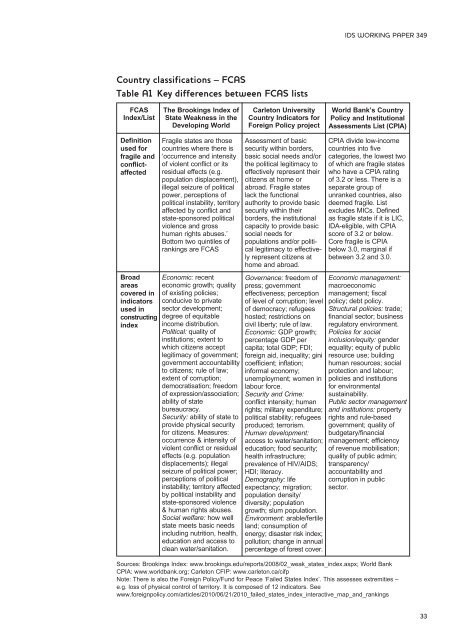Andy Sumner - Institute of Development Studies
Andy Sumner - Institute of Development Studies
Andy Sumner - Institute of Development Studies
You also want an ePaper? Increase the reach of your titles
YUMPU automatically turns print PDFs into web optimized ePapers that Google loves.
IDS WORKING PAPER 349Country classifications – FCASTable A1 Key differences between FCAS listsFCASIndex/ListThe Brookings Index <strong>of</strong>State Weakness in theDeveloping WorldCarleton UniversityCountry Indicators forForeign Policy projectWorld Bank’s CountryPolicy and InstitutionalAssessments List (CPIA)Definitionused forfragile andconflictaffectedBroadareascovered inindicatorsused inconstructingindexFragile states are thosecountries where there is‘occurrence and intensity<strong>of</strong> violent conflict or itsresidual effects (e.g.population displacement),illegal seizure <strong>of</strong> politicalpower, perceptions <strong>of</strong>political instability, territoryaffected by conflict andstate-sponsored politicalviolence and grosshuman rights abuses.’Bottom two quintiles <strong>of</strong>rankings are FCASEconomic: recenteconomic growth; quality<strong>of</strong> existing policies;conducive to privatesector development;degree <strong>of</strong> equitableincome distribution.Political: quality <strong>of</strong>institutions; extent towhich citizens acceptlegitimacy <strong>of</strong> government;government accountabilityto citizens; rule <strong>of</strong> law;extent <strong>of</strong> corruption;democratisation; freedom<strong>of</strong> expression/association;ability <strong>of</strong> statebureaucracy.Security: ability <strong>of</strong> state toprovide physical securityfor citizens. Measures:occurrence & intensity <strong>of</strong>violent conflict or residualeffects (e.g. populationdisplacements); illegalseizure <strong>of</strong> political power;perceptions <strong>of</strong> politicalinstability; territory affectedby political instability andstate-sponsored violence& human rights abuses.Social welfare: how wellstate meets basic needsincluding nutrition, health,education and access toclean water/sanitation.Assessment <strong>of</strong> basicsecurity within borders,basic social needs and/orthe political legitimacy toeffectively represent theircitizens at home orabroad. Fragile stateslack the functionalauthority to provide basicsecurity within theirborders, the institutionalcapacity to provide basicsocial needs forpopulations and/or politicallegitimacy to effectivelyrepresent citizens athome and abroad.Governance: freedom <strong>of</strong>press; governmenteffectiveness; perception<strong>of</strong> level <strong>of</strong> corruption; level<strong>of</strong> democracy; refugeeshosted; restrictions oncivil liberty; rule <strong>of</strong> law.Economic: GDP growth;percentage GDP percapita; total GDP; FDI;foreign aid, inequality; ginicoefficient; inflation;informal economy;unemployment; women inlabour force.Security and Crime:conflict intensity; humanrights; military expenditure;political stability; refugeesproduced; terrorism.Human development:access to water/sanitation;education; food security;health infrastructure;prevalence <strong>of</strong> HIV/AIDS;HDI; literacy.Demography: lifeexpectancy; migration;population density/diversity; populationgrowth; slum population.Environment: arable/fertileland; consumption <strong>of</strong>energy; disaster risk index;pollution; change in annualpercentage <strong>of</strong> forest cover.CPIA divide low-incomecountries into fivecategories, the lowest two<strong>of</strong> which are fragile stateswho have a CPIA rating<strong>of</strong> 3.2 or less. There is aseparate group <strong>of</strong>unranked countries, alsodeemed fragile. Listexcludes MICs. Definedas fragile state if it is LIC,IDA-eligible, with CPIAscore <strong>of</strong> 3.2 or below.Core fragile is CPIAbelow 3.0, marginal ifbetween 3.2 and 3.0.Economic management:macroeconomicmanagement; fiscalpolicy; debt policy.Structural policies: trade;financial sector; businessregulatory environment.Policies for socialinclusion/equity: genderequality; equity <strong>of</strong> publicresource use; buildinghuman resources; socialprotection and labour;policies and institutionsfor environmentalsustainability.Public sector managementand institutions: propertyrights and rule-basedgovernment; quality <strong>of</strong>budgetary/financialmanagement; efficiency<strong>of</strong> revenue mobilisation;quality <strong>of</strong> public admin;transparency/accountability andcorruption in publicsector.Sources: Brookings Index: www.brookings.edu/reports/2008/02_weak_states_index.aspx; World BankCPIA: www.worldbank.org; Carleton CFIP: www.carleton.ca/cifpNote: There is also the Foreign Policy/Fund for Peace ‘Failed States Index’. This assesses extremities –e.g. loss <strong>of</strong> physical control <strong>of</strong> territory. It is composed <strong>of</strong> 12 indicators. Seewww.foreignpolicy.com/articles/2010/06/21/2010_failed_states_index_interactive_map_and_rankings33
















